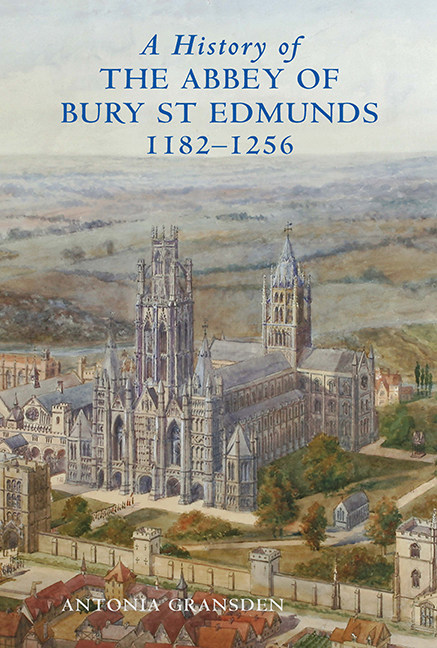Book contents
- Frontmatter
- Dedication
- Contents
- List of plates
- List of figures
- Preface
- Editorial Note
- Epigraph
- Acknowledgements
- Maps and plans (figures 1–9)
- Part I Samson of Tottington, Abbot 1182–1211
- 1 Samson's biographer, Jocelin of Brackland (de Brakelond), and his work
- 2 Samson's early life and career
- 3 Samson's election to the abbacy
- 4 The early years of Samson's abbacy and reform of estate management
- 5 Conflict with the convent
- 6 Relations with the town of Bury St Edmunds
- 7 Samson and secular law
- 8 Samson and the knights of St Edmund
- 9 Relations with the Angevin kings
- 10 Samson and the papacy
- 11 Samson as a builder
- 12 Religious and intellectual life under Samson
- 13 Samson's death and burial
- PART II The Abbey 1212–1256
- APPENDICES
6 - Relations with the town of Bury St Edmunds
from Part I - Samson of Tottington, Abbot 1182–1211
Published online by Cambridge University Press: 29 April 2017
- Frontmatter
- Dedication
- Contents
- List of plates
- List of figures
- Preface
- Editorial Note
- Epigraph
- Acknowledgements
- Maps and plans (figures 1–9)
- Part I Samson of Tottington, Abbot 1182–1211
- 1 Samson's biographer, Jocelin of Brackland (de Brakelond), and his work
- 2 Samson's early life and career
- 3 Samson's election to the abbacy
- 4 The early years of Samson's abbacy and reform of estate management
- 5 Conflict with the convent
- 6 Relations with the town of Bury St Edmunds
- 7 Samson and secular law
- 8 Samson and the knights of St Edmund
- 9 Relations with the Angevin kings
- 10 Samson and the papacy
- 11 Samson as a builder
- 12 Religious and intellectual life under Samson
- 13 Samson's death and burial
- PART II The Abbey 1212–1256
- APPENDICES
Summary
Jocelin's account of the convent's confrontation with Samson in 1202 is probably selective. The monks may well have also complained about other things about which Jocelin is silent. But the complaints which he does mention as made on that occasion all concern the administration of the town. They are matters which figure earlier in his narrative as subjects of dispute and which also occupy clauses in the Composition. Obviously, the town was a major cause of dispute between Samson and the convent.
The town of Bury St Edmunds comprised two elements: first the highly privileged Liberty of the banleuca where the abbot had regalian rights and ecclesiastical jurisdiction. This was the borough (burgus) and the free tenants in it the burgesses (burgenses); secondly, there were the suburbs. However, prosperous free tenants in the suburbs were numbered among the burgesses, and unfree tenants in the banleuca were not. Certainly, townsmen and burgesses acted together in attempts to throw off the overriding control of abbot, sacrist and cellarer. They were unsuccessful and Bury St Edmunds never attained the status of a borough in the strict sense, with a royal charter. In view of the division of power in the town's government, it is not surprising that it caused disputes between abbot and convent. The town belonged to the convent and within the banleuca the abbot's regalian rights and ecclesiastical jurisdiction was exercised on his behalf by the sacrist: and as the abbot's deputy the sacrist was archdeacon and entitled to archidiaconal rights and revenues. On the other hand, the cellarer held the manor in the suburbs with the usual rights and revenues of a manorial lord. But the abbot had overall responsibilities for the town's good government and in particular for the banleuca for which he was answerable to the king and pope. Disputes between the sacrist and cellarer over the respective areas of authority reduced efficiency and could lead to disorder, while the abbot's intervention was resented by whomever suffered from it.
The day-to-day administration of the town was in the hands of one or two reeves (until c. 1220–1240 there was usually only one reeve; later there were always two).
- Type
- Chapter
- Information
- A History of the Abbey of Bury St Edmunds, 1182–1256Samson of Tottington to Edmund of Walpole, pp. 44 - 50Publisher: Boydell & BrewerPrint publication year: 2007



